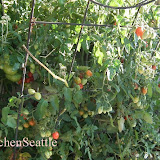It is nice to have fresh herbs and vegetables nearby to add seasonal fresh touch to homemade dish. I have some edible plants around my Prune kitchen.
There are a large Grape vine by a gate to the Prune kitchen, raspberries, green beans Japanese pepper plants, Shiso(Japanese fragrant green leave), Mint, Rosemarie, and Sage in side yard, , cherries, Rhubarb, cabbage, tomatoes, Chinese chives and green onion in the backyard. The new residence with the Prune kitchen get more sun shine than my previous house. Last fall, I dag the rocky and hard ground around Prune Kitchen, added many bags of composed and organic fertilizers, and planted vegetables. My hard labor paid off and I have vegetables in my garden. Tomatoes start ripening two weeks ago and until Seattle’s rainy fall starts, I will have enough fresh tomatoes for my everyday salad.
Beginning this summer,when I trimmed overgrown grape vines, I realized that I can save some tender fresh grape leaves to make stuffed grape leaves(Dolmathakia Me Rizi.) I searched the recipe and made some for my family and cooked with members of “Seattle let us cook together meetup.” The Dalmathakia Me Rizi was interesting taste to me while meetup members who cooked and ate dalmathkia said it was very delicious. We made as many as 60 of them and they were gone. Here is how I made dalmathakia Me Rizi.
I cooked fresh leaves using
Grape Leaves-Canning recipe from food.com .
Then I used some of cooked leaves and
a recipe from Greekcuisine.com to make Dolmathakia Me Rizi. As you see the recipe, it contains too much oil and I reduced oil amount to a half of the recipe and steamed instead of boiling.
Lastly useful fresh herbs are Rosemarie and green onion. It enhance the taste of pork dish and add nice aroma and flavor to the pasta dish when cooked it with Tomatoes and chili flakes. Green onion is for Japanese soup and add color to the salad.









